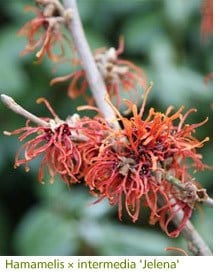Indestructible, desirable and beguiling - the witch hazel
The most winter-rugged flowers of all are the witch hazels (named forms of Hamamelis), with their strands of ribbon-like petals that shrug off heavy rain, frost and snow without browning, or withering. The flowers come in marmalade shades, ranging from burnt-orange, to citrus-peel yellow, through to paprika-red. The ribbons form spiders that seem to cling to the bare, dark branches. Close up, these ribbons often nestle in colourful red cups (or calices) providing a crisp contrast to warm up any winter's day. Some also colour up well in autumn.
 Witch hazels span two continents in the wild, Asia and North America. When plant hunters introduced Asian species into America in the early years of the 20th century they hybridised with their American cousins to produce larger flowered hybrids now known as H. x intermedia. Some named forms were deliberately bred by enthusiasts like the de Belder family who developed Kalmthout Arboretum in Belgium. They often chose family names and they include the widely grown 'Jelena' (a non-scented russet-brown from 1954) and 'Diane' (a slightly scented deep-red from 1969).
Witch hazels span two continents in the wild, Asia and North America. When plant hunters introduced Asian species into America in the early years of the 20th century they hybridised with their American cousins to produce larger flowered hybrids now known as H. x intermedia. Some named forms were deliberately bred by enthusiasts like the de Belder family who developed Kalmthout Arboretum in Belgium. They often chose family names and they include the widely grown 'Jelena' (a non-scented russet-brown from 1954) and 'Diane' (a slightly scented deep-red from 1969).
Others appeared by themselves and these include the mysterious 'Pallida', which was first spotted on Battleston Hill at RHS Wisley in the 1940s and was probably a seedling. 'Pallida' remains the best pale-yellow witch hazel to look at and it also has an extraordinary scent, reminiscent of freesias. Many witch hazels are scented, although not all, but their fragrance varies from medicinal, to toilet cleaner, to floral. The yellows tend to have more scent and 'Arnold Promise' (a late variety developed at the Arnold Arboretum in America in 1963) has lots of small yellow flowers with a sweet, strong scent.

It's a popular misconception that witch hazels need acid-soil to thrive. They need good moisture-retentive soil, so won't thrive on chalk or thin soil. Other than that they do well on most. Like many plants with an Asian pedigree, or part pedigree, they need summer rainfall to emulate the rainy season. They also need good light to encourage next year's flower buds. They clearly signal their thirst in summer by turning their leaves to a vertical angle to slow down transpiration. This means they require water and lots of it. Gently tip two buckets over their roots and repeat this every time their foliage slants downwards.
Witch hazels vary in shape and size, although they are all slow-growing and shrubby rather than tree-like. For this reason pruning is limited to a tidy after flowering, only if needed. Remove any crossing branches or damaged wood and tip back the leaders a little to promote more flower bud, if you wish. Buy your witch hazels now, when in flower, but keep them somewhere sheltered and plant them outside once spring arrives. They also do well in containers.





